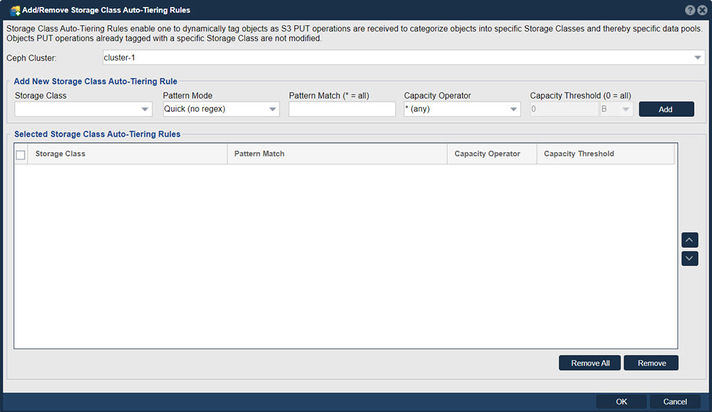Add Remove Ceph Storage Class Rules

In QuantaStor, the feature "Add/Remove Ceph Storage Class Rules" refers to the capability to manage the rules associated with Ceph storage classes. Ceph is a distributed storage system commonly used for object storage, block storage, and file storage. Storage class rules in Ceph allow administrators to define policies for data placement, replication, and management based on various criteria. Here's the purpose of adding or removing Ceph storage class rules in QuantaStor:
- Data Placement Policies: Ceph storage class rules enable administrators to define policies for data placement based on factors such as storage capacity, performance requirements, and access patterns. By configuring these rules, administrators can ensure that data is stored on appropriate storage tiers within the Ceph cluster to meet application requirements.
- Replication and Redundancy: Storage class rules in Ceph allow administrators to specify replication and redundancy settings for data stored within different storage classes. This ensures data resilience and high availability by replicating data across multiple storage nodes or clusters according to the defined rules.
- Performance Optimization: Administrators can use Ceph storage class rules to optimize storage performance by specifying placement policies that take into account factors such as disk type, network bandwidth, and workload characteristics. By aligning data placement with performance requirements, administrators can ensure that applications receive the necessary performance levels.
- Data Lifecycle Management: Storage class rules enable administrators to define policies for data lifecycle management, including data retention, archiving, and deletion. By configuring these rules, administrators can automate the movement of data between different storage tiers within the Ceph cluster based on predefined criteria, such as access frequency or age of data.
- Cost Optimization: By defining storage class rules, administrators can optimize storage costs by tiering data based on its importance and access patterns. They can store less frequently accessed data on lower-cost storage tiers while keeping frequently accessed data on higher-performance tiers, thereby optimizing storage costs without sacrificing performance.
- Scalability and Flexibility: Storage class rules in Ceph provide administrators with the flexibility to adapt storage configurations to changing requirements and workload demands. Administrators can dynamically add or remove rules to adjust data placement policies, replication settings, and other parameters as needed to accommodate evolving storage needs.
In summary, the purpose of adding or removing Ceph storage class rules in QuantaStor is to enable administrators to define policies for data placement, replication, performance optimization, lifecycle management, cost optimization, and scalability within the Ceph storage cluster, thereby ensuring efficient and effective storage management.
Navigation: Scale-out Storage Configuration --> Scale-out Storage Pools --> [Cluster] --> Add/Remove Storage Class Auto-Tiering Rules... (right-click)